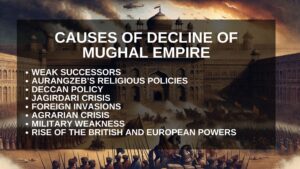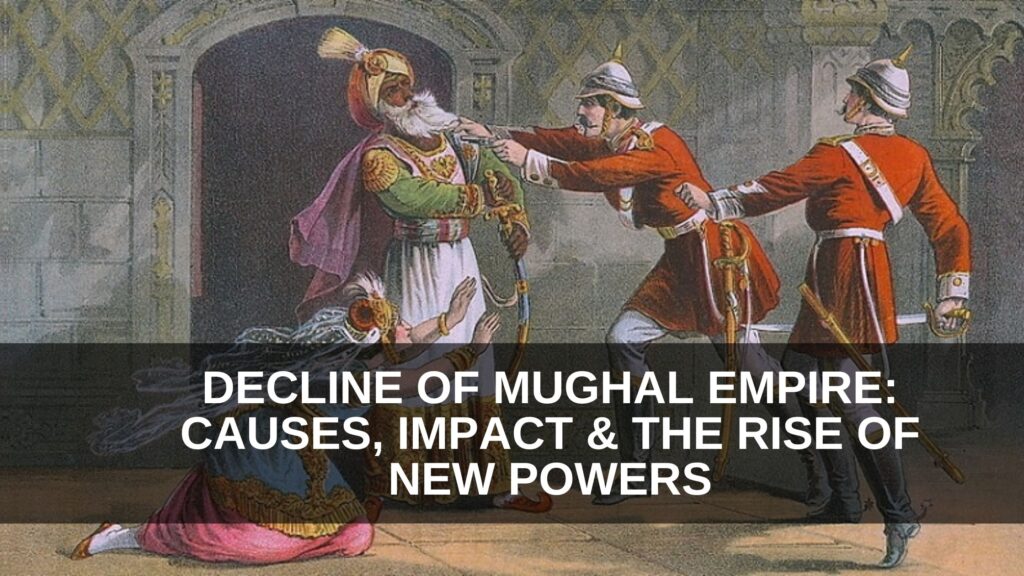The Later Mughals period marks a significant chapter in Indian history, characterized by the gradual decline of the Mughal Empire. Spanning from the late 17th century to the mid-19th century, this era was defined by internal conflicts, external threats, and political instability, all of which contributed to the weakening of Mughal authority.
From the reign of Aurangzeb to the last Mughal ruler, Bahadur Shah II, the empire saw a steady decline due to power struggles and socio-political changes.
Later Mughals
The Later Mughals were rulers who succeeded Aurangzeb but failed to restore the empire’s former glory. Below is a list of significant Later Mughal rulers and key events during their reign:
Download notes of The Rise and Fall of the Mughal Empire
Bahadur Shah I (Muazzam/Shah Alam I) (1709-1712)
- Succeeded Aurangzeb after a two-year-long war of succession.
- Adopted a pacifist policy towards the Marathas and released the Maratha prince Shahuji.
- Followed a conciliatory policy towards the Rajputs.
- Historian Khafi Khan gave him the title Shah-e-Bekhabaran.
Jahandar Shah (1712-1713)
- Ascended the throne with the support of Zulfikar Khan.
- Adopted a friendly policy towards the Marathas and Rajputs.
- Abolished the Jizyah tax.
- Introduced the Izaredari System (revenue farming).
Farrukh Siyar (1713-1719)
- Came to power with the help of the Sayyid Brothers (Abdullah Khan and Hasan Ali), also known as the kingmakers.
- Captured and executed Banda Bahadur, the Sikh chief.
- Granted the East India Company duty-free trading rights in Bengal (1717).
Muhammad Shah (1719-1748)
- Known as ‘Rangeela’ due to his luxurious lifestyle.
- Removed the Sayyid Brothers from power.
- Faced a Persian invasion by Nadir Shah in 1738-39, leading to the plundering of Delhi and loss of the Koh-i-Noor diamond and Peacock Throne.
Ahmad Shah (1748-1754)
- Faced invasions by Ahmad Shah Abdali (1749 & 1752), leading to the loss of Punjab and Multan.
Alamgir II (1754-1759)
- The Mughal Empire weakened further under his rule.
- The Battle of Plassey (1757) took place during his reign, marking the beginning of British dominance in India.
Shah Alam II (1759-1806)
- Fought in the Third Battle of Panipat (1761) and Battle of Buxar (1764).
- Became a pensioner of the East India Company after the Battle of Buxar.
- Issued a farman granting the British Diwani rights over Bengal, Bihar, and Orissa.
Akbar Shah II (1806-1837)
- Conferred the title of ‘Raja’ to social reformer Raja Rammohan Roy.
- The British stopped minting coins bearing the Mughal emperor’s name in 1835.
Bahadur Shah II (1837-1857)
- The last Mughal Emperor.
- Adopted the title ‘Zafar’, being a poet.
- After the Revolt of 1857, he was captured by the British and exiled to Rangoon, where he died in 1862.
Decline of the Mughal Empire
The Mughal Empire began its decline after the death of Aurangzeb in 1707. The once-mighty empire faced internal divisions, administrative failures, and external invasions, leading to its eventual collapse.
Causes of Decline of Mughal Empire

- Weak Successors:
- No clear succession law led to frequent wars of succession.
- Later Mughal rulers were weak and easily manipulated by powerful nobles.
- Aurangzeb’s Religious Policies:
- Reimposed Jizyah tax, destroyed temples, and levied taxes on Hindu merchants.
- Alienated the Rajputs, Sikhs, and Marathas, leading to continuous conflicts.
- Deccan Policy:
- Aurangzeb’s prolonged campaign in the Deccan drained the empire’s resources.
- The destruction of Bijapur and Golconda brought the empire into direct conflict with the Marathas.
- Jagirdari Crisis:
- The number of Jagirdars increased beyond the available land, causing financial strain.
- Rivalry among nobles over Jagirs led to administrative inefficiency.
- Foreign Invasions:
- Nadir Shah’s invasion (1739) and Ahmad Shah Abdali’s multiple invasions (1749-1761) severely weakened the empire.
- Agrarian Crisis:
- Heavy taxation led to peasant revolts.
- Frequent jagir rotations disrupted revenue collection.
- Military Weakness:
- The Mughal army became outdated, losing battles to the British and regional powers.
- Lack of a naval force proved disastrous against European trading companies.
- Rise of the British and European Powers:
- The British, Portuguese, and French took advantage of the declining empire, expanding their influence through trade and military dominance.
Emergence of Regional Powers
With the decline of Mughal authority, several regional powers emerged:
1. Hyderabad
- Founded by Nizam-ul-Mulk Asaf Jah (1724).
- Maintained nominal Mughal allegiance but ruled independently.
2. Awadh
- Saadat Khan established Awadh in 1722.
- Controlled trade between Bengal and North India.
3. Bengal
- Murshid Quli Khan ruled independently while reducing Mughal influence.
- Hindu bankers and zamindars gained power.
4. Marathas
- Expanded across Malwa, Gujarat, Rajasthan, and Punjab.
- Introduced Chauth and Sardeshmukhi taxes.
5. Rajputs
- Rajput states like Jodhpur and Jaipur extended their control over nearby regions.
6. Sikhs
- Established the Dal Khalsa and later Maharaja Ranjit Singh (1799-1839) unified Punjab.
7. Jats
- Controlled areas around Delhi, Mathura, and Agra.
- Established trading centers like Ballabhgarh and Panipat.
8. Afghans (Rohillakhand)
- Ali Mohammad Khan established the kingdom of Rohillakhand.
9. Farrukhabad
- Mohammad Khan Bangash founded Farrukhabad in Uttar Pradesh.
Revenue System in the Later Mughal Era
Izaredari System
- Introduced by Jahandar Shah (1712-13) and later expanded.
- Revenue collection rights auctioned to the highest bidder.
- Exploited peasants as tax collectors overcharged them.
Differences between Zamindari and Ijaradari Systems
- Zamindari was hereditary, whereas Ijaradari was temporary and auction-based.
- Zamindars were local landlords, while Ijaradars were revenue farmers from cities.
Download notes of The Bhakti Movement in North India
The Later Mughals era witnessed the decline of the once-mighty Mughal Empire. Internal conflicts, external invasions, and socio-political shifts led to the empire’s downfall. As the Mughals lost control, regional powers like the Marathas, Sikhs, and Rajputs rose, shaping the political landscape of 18th-century India. The final blow came with the British consolidation of power, leading to the end of Mughal rule in 1857.


